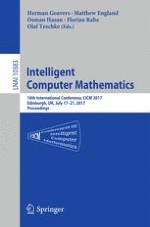This book constitutes the refereed proceedings of the 10th International Conference on Intelligent Computer Mathematics, CICM 2017, held in Edinburgh, Scotland, in July 2017.
The 22 full papers and 3 abstracts of invited papers presented were carefully reviewed and selected from a total of 40 submissions. The papers are organized in three tracks: the Calculemus track examining the integration of symbolic computation and mechanized reasoning; the Digital Mathematics Libraries track dealing with math-aware technologies, standards, algorithms, and processes; the Mathematical Knowledge Management track being concerned with all aspects of managing mathematical knowledge, in informal, semi-formal, and formal settings. An additional track Systems and Projects contains descriptions of systems and relevant projects, both of which are key to a research topic where theory and practice interact on explicitly represented knowledge.













